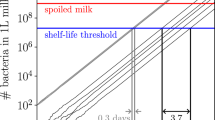Summary
Statistical calculations are made of the distribution numbers of mutants in a culture of bacteria in which the number of mutants increases on account both of new mutations and of division of old mutants. In this way the largely qualitative conclusions of Luria and Delbruck are extended and placed on a firm quantitative basis. The results of these calculations, which enable the mutation rate to be inferred from experiments with parallel cultures, are presented in the form of tables. Statistically efficient methods of using these tables are discussed.
Similar content being viewed by others
References
Adolph, E. F. &Bayne-Jones, S. (1932).J. Cell. Comp. Physiol. 1, 409.
Demerec, M. (1945).Proc. Nat. Acad. Sci., Wash.,31, 16.
Fisher, R. A. (1938).Statistical Theory of Estimations. Calcutta University Readership lectures.
Fisher, R. A. &Yates, F. (1938).Statistical Tables for Biologists, Agriculturalists and Medical Research. Edinburgh: Oliver and Boyd.
Lewis, I. M. (1934).J. Bact. 28, 619.
Luria, S. E. &Delbruck, M. (1943).Genetics,28, 491.
Molina, E. C. D. (1942).Poisson's Exponential Binomial Limit Tables. New York: Van Nostrand.
Stewart, F. M. (1947).J. Hyg., Camb.,45, 28.
Witkin, E. M. (1946).Proc. Nat. Acad. Sci., Wash.,32, 59.
Author information
Authors and Affiliations
Additional information
[Note by C. A. C. A few days before Dr Lea's untimely death in June 1947, the manuscript and the calculations reported here had just been completed. It was Dr Lea's intention to make further experiments more suitable to a test of the theory outlined in this paper. These experiments cannot now be made, but it has been thought wise to publish the theory and numerical tables because of their value to other investigators.]
Rights and permissions
About this article
Cite this article
Lea, D.E., Coulson, C.A. The distribution of the numbers of mutants in bacterial populations. Journ. of Genetics 49, 264–285 (1949). https://doi.org/10.1007/BF02986080
Issue Date:
DOI: https://doi.org/10.1007/BF02986080




